Speed Estimation of Six-Phase Induction Motors, Using the Rotor Slot Harmonics
Abstract
1. Introduction
2. The Theory of the Proposed Technique
- ➢
- Acquisition of one-phase current ;
- ➢
- Frequencies determination: The DFT transforms a finite discrete-time signal into a finite or discrete number of frequencies. For a finite sequence of length n {x(n) 0 ≤ n ≤ N−1}, the DFT is given by (4), but the angular frequency is continuous. This constraint is solved by discretising the frequency; the resulting DFT is given by (5). Equation (5) has a finite sequence length and is repeated periodically {x(n) = 0, N ≤ n ≤ L−1}, and is thus obtained from (4) as follows [51]:
- ➢
- The inverse DFT (6) is obtained from (5) as:
- ➢
- Estimation of the magnitude and frequency of the PSH related to the phase current: A high-resolution spectral analysis, based on the STFT technique, is used in this phase of the strategy. The STFT is based on a short-time sliding window and the DFT method. This approach can reliably estimate and monitor all harmonic properties (frequency and amplitude) from a short data record signal, allowing the non-stationary part of the problem to be considered [51].
3. Experimental Results
4. Conclusions
- (1)
- Independence from motor parameters, rotor type, or perturbations with the potential to interfere in the estimation procedure—fault-related harmonic components, for instance;
- (2)
- Enhanced performance and reliability for speed estimation of IMs;
- (3)
- Ease of implementation;
- (4)
- Estimation accuracy is higher than 99.987%.
Author Contributions
Funding
Institutional Review Board Statement
Informed Consent Statement
Data Availability Statement
Acknowledgments
Conflicts of Interest
References
- Levi, E. Multiphase electric machines for variable-speed applications. IEEE Trans. Ind. Electron. 2008, 55, 1893–1909. [Google Scholar] [CrossRef]
- Pantea, A.; Yazidi, A.; Betin, F.; Taherzadeh, M.; Carrière, S.; Henao, H.; Capolino, G.-A. Six-phase induction machine model for electrical fault simulation using the circuit-oriented method. IEEE Trans. Ind. Electron. 2015, 63, 494–503. [Google Scholar] [CrossRef]
- Levi, E. Advances in converter control and innovative exploitation of additional degrees of freedom for multiphase machines. IEEE Trans. Ind. Electron. 2015, 63, 433–448. [Google Scholar] [CrossRef]
- Levi, E.; Bojoi, R.; Profumo, F.; Toliyat, H.A.; Williamson, S. Multiphase induction motor drives—A technology status review. IET Electr. Power Appl. 2007, 1, 489–516. [Google Scholar] [CrossRef]
- Zhang, Y.; Yin, Z.; Bai, C.; Wang, G.; Liu, J. A rotor position and speed estimation method using an improved linear extended state observer for IPMSM sensorless drives. IEEE Trans. Power Electron. 2021, 36, 14062–14073. [Google Scholar] [CrossRef]
- Caruana, C.; Asher, G.M.; Sumner, M. Performance of HF signal injection techniques for zero-low-frequency vector control of induction machines under sensorless conditions. IEEE Trans. Ind. Electron. 2006, 53, 225–238. [Google Scholar] [CrossRef]
- Lu, S.; Yan, R.; Liu, Y.; Wang, Q. Tacholess speed estimation in order tracking: A review with application to rotating machine fault diagnosis. IEEE Trans. Instrum. Meas. 2019, 68, 2315–2332. [Google Scholar] [CrossRef]
- Natili, F.; Castellani, F.; Astolfi, D.; Becchetti, M. Video-tachometer methodology for wind turbine rotor speed measurement. Sensors 2020, 20, 7314. [Google Scholar] [CrossRef]
- Consoli, A.; Scarcella, G.; Scelba, G.; Royak, S.; Harbaugh, M.M. Implementation issues in voltage zero sequence-based encoderless techniques. IEEE Trans. Ind. Appl. 2008, 44, 144–152. [Google Scholar] [CrossRef]
- Sahraoui, M.; Cardoso, A.J.M.; Yahia, K.; Ghoggal, A. The use of the modified Prony’s method for rotor speed estimation in squirrel-cage induction motors. IEEE Trans. Ind. Appl. 2016, 52, 2194–2202. [Google Scholar] [CrossRef]
- Yu, J.; Shen, H.; Wang, H.; Wu, X. Speed Estimation of Multiphase Induction Motor using Rotor Slot Harmonics with Limited SNR and Dynamic Load Conditions. IEEE Trans. Ind. Electron. 2022. [Google Scholar] [CrossRef]
- Yepes, A.G.; Doval-Gandoy, J.; Baneira, F.; Toliyat, H.A. Speed estimation based on rotor slot harmonics in multiphase induction machines under open-phase fault. IEEE Trans. Power Electron. 2017, 33, 7980–7993. [Google Scholar] [CrossRef]
- Xu, Z.; Zhang, T.; Bao, Y.; Zhang, H.; Gerada, C. A nonlinear extended state observer for rotor position and speed estimation for sensorless IPMSM drives. IEEE Trans. Power Electron. 2019, 35, 733–743. [Google Scholar] [CrossRef]
- Wang, H.; Yang, Y.; Ge, X.; Zuo, Y.; Yue, Y.; Li, S. PLL- and FLL-Based Speed Estimation Schemes for Speed-Sensorless Control of Induction Motor Drives: Review and New Attempts. IEEE Trans. Power Electron. 2022, 37, 3334–3356. [Google Scholar] [CrossRef]
- Chen, J.; Huang, J. Globally stable speed-adaptive observer with auxiliary states for sensorless induction motor drives. IEEE Trans. Power Electron. 2018, 34, 33–39. [Google Scholar] [CrossRef]
- Chirindo, M.; Khan, M.A.; Barendse, P. Analysis of non-intrusive rotor speed estimation techniques for inverter-fed induction motors. IEEE Trans. Energy Convers. 2020, 36, 338–347. [Google Scholar] [CrossRef]
- Chen, J.; Huang, J.; Sun, Y. Resistances and speed estimation in sensorless induction motor drives using a model with known regressors. IEEE Trans. Ind. Electron. 2018, 66, 2659–2667. [Google Scholar] [CrossRef]
- Orlowska-Kowalska, T.; Korzonek, M.; Tarchala, G. Stability improvement methods of the adaptive full-order observer for sensorless induction motor drive—Comparative study. IEEE Trans. Ind. Inform. 2019, 15, 6114–6126. [Google Scholar] [CrossRef]
- Chen, J.; Huang, J. Alternative solution regarding problems of adaptive observer compensating parameters uncertainties for sensorless induction motor drives. IEEE Trans. Ind. Electron. 2019, 67, 5879–5888. [Google Scholar] [CrossRef]
- Zhang, Y.; Yin, Z.; Zhang, Y.; Liu, J.; Tong, X. A novel sliding mode observer with optimized constant rate reaching law for sensorless control of induction motor. IEEE Trans. Ind. Electron. 2019, 67, 5867–5878. [Google Scholar] [CrossRef]
- Korzonek, M.; Tarchala, G.; Orlowska-Kowalska, T. A review on MRAS-type speed estimators for reliable and efficient induction motor drives. ISA Trans. 2019, 93, 1–13. [Google Scholar] [CrossRef] [PubMed]
- Korzonek, M.; Tarchala, G.; Orlowska-Kowalska, T. Simple stability enhancement method for stator current error-based MRAS-Type speed estimator for induction motor. IEEE Trans. Ind. Electron. 2019, 67, 5854–5866. [Google Scholar] [CrossRef]
- Meira, M.; Bossio, G.R.; Verucchi, C.J.; Ruschetti, C.R.; Bossio, J.M. Speed estimation during the starting transient of induction motors. IEEE Trans. Instrum. Meas. 2020, 70, 1–8. [Google Scholar] [CrossRef]
- Kivanc, O.C.; Ozturk, S.B. Sensorless PMSM drive based on stator feedforward voltage estimation improved with MRAS multiparameter estimation. IEEE/ASME Trans. Mechatron. 2018, 23, 1326–1337. [Google Scholar] [CrossRef]
- Montanari, M.; Peresada, S.M.; Rossi, C.; Tilli, A. Speed sensorless control of induction motors based on a reduced-order adaptive observer. IEEE Trans. Control Syst. Technol. 2007, 15, 1049–1064. [Google Scholar] [CrossRef]
- Zerdali, E.; Barut, M. The comparisons of optimized extended Kalman filters for speed-sensorless control of induction motors. IEEE Trans. Ind. Electron. 2017, 64, 4340–4351. [Google Scholar] [CrossRef]
- Xu, W.; Qu, S.; Zhao, J.; Zhang, H.; Du, X. An improved full-order sliding-mode observer for rotor position and speed estimation of SPMSM. IEEE Access 2021, 9, 15099–15109. [Google Scholar] [CrossRef]
- Wang, H.; Ge, X.; Liu, Y.-C. Second-order sliding-mode MRAS observer-based sensorless vector control of linear induction motor drives for medium-low speed maglev applications. IEEE Trans. Ind. Electron. 2018, 65, 9938–9952. [Google Scholar] [CrossRef]
- Du, C.; Yin, Z.; Zhang, Y.; Liu, J.; Sun, X.; Zhong, Y. Research on active disturbance rejection control with parameter autotune mechanism for induction motors based on adaptive particle swarm optimization algorithm with dynamic inertia weight. IEEE Trans. Power Electron. 2018, 34, 2841–2855. [Google Scholar] [CrossRef]
- Morawiec, M.; Kroplewski, P.; Odeh, C. Nonadaptive rotor speed estimation of induction machine in an adaptive full-order observer. IEEE Trans. Ind. Electron. 2021, 69, 2333–2344. [Google Scholar] [CrossRef]
- Hung, C.-Y.; Liu, P.; Lian, K.-Y. Fuzzy virtual reference model sensorless tracking control for linear induction motors. IEEE Trans. Cybern. 2013, 43, 970–981. [Google Scholar] [CrossRef] [PubMed]
- Luo, H.; Lv, Y.; Deng, X.; Zhang, H. Optimization of adaptation gains of full-order flux observer in sensorless induction motor drives using genetic algorithm. Inf. Technol. J. 2009, 8, 577–582. [Google Scholar] [CrossRef][Green Version]
- Gadoue, S.M.; Giaouris, D.; Finch, J.W. Sensorless control of induction motor drives at very low and zero speeds using neural network flux observers. IEEE Trans. Ind. Electron. 2009, 56, 3029–3039. [Google Scholar] [CrossRef]
- Karanayil, B.; Rahman, M.F.; Grantham, C. Online stator and rotor resistance estimation scheme using artificial neural networks for vector controlled speed sensorless induction motor drive. IEEE Trans. Ind. Electron. 2007, 54, 167–176. [Google Scholar] [CrossRef]
- Thomas, J.; Hansson, A. Speed tracking of a linear induction motor-enumerative nonlinear model predictive control. IEEE Trans. Control Syst. Technol. 2012, 21, 1956–1962. [Google Scholar] [CrossRef]
- Silva, W.L.; Lima, A.M.N.; Oliveira, A. Speed estimation of an induction motor operating in the nonstationary mode by using rotor slot harmonics. IEEE Trans. Instrum. Meas. 2014, 64, 984–994. [Google Scholar] [CrossRef]
- Gao, Z.; Turner, L.; Colby, R.S.; Leprettre, B. A frequency demodulation approach to induction motor speed detection. IEEE Trans. Ind. Appl. 2011, 47, 1632–1642. [Google Scholar] [CrossRef]
- Nandi, S.; Ahmed, S.; Toliyat, H.A. Detection of rotor slot and other eccentricity related harmonics in a three phase induction motor with different rotor cages. IEEE Trans. Energy Convers. 2001, 16, 253–260. [Google Scholar] [CrossRef]
- Meira, M.; Ruschetti, C.; Verucchi, C.; Bossio, J.M.; Bossio, G. A speed estimation strategy for wound rotor induction motor. In Proceedings of the 2018 IEEE Biennial Congress of Argentina (ARGENCON), San Miguel de Tucuman, Argentina, 6–8 June 2018; pp. 1–8. [Google Scholar]
- Keysan, O.; Ertan, H.B. Real-time speed and position estimation using rotor slot harmonics. IEEE Trans. Ind. Inform. 2012, 9, 899–908. [Google Scholar] [CrossRef]
- Zappalá, D.; Sarma, N.; Djurović, S.; Crabtree, C.J.; Mohammad, A.; Tavner, P.J. Electrical & mechanical diagnostic indicators of wind turbine induction generator rotor faults. Renew. Energy 2019, 131, 14–24. [Google Scholar] [CrossRef]
- Blasco, R.; Sumner, M.; Asher, G.M. Speed measurement of inverter fed induction motors using the FFT and the rotor slot harmonics. In Proceedings of the 5th International Conference on Power Electronics and Variable-Speed Drives, London, UK, 26–28 October 1994; pp. 470–475. [Google Scholar]
- Hurst, K.D.; Habetler, T.G. A comparison of spectrum estimation techniques for sensorless speed detection in induction machines. IEEE Trans. Ind. Appl. 1997, 33, 898–905. [Google Scholar] [CrossRef]
- Aiello, M.; Cataliotti, A.; Nuccio, S. An induction motor speed measurement method based on current harmonic analysis with the chirp-Z transform. IEEE Trans. Instrum. Meas. 2005, 54, 1811–1819. [Google Scholar] [CrossRef]
- Tshiloz, K.; Djukanovic, S.; Djurovic, S. Real-time sensorless speed estimation in wound rotor induction machines using a dichotomous search algorithm. In Proceedings of the 2015 IEEE International Electric Machines & Drives Conference (IEMDC), Coeur d’Alene, ID, USA, 10–13 May 2015; pp. 1036–1042. [Google Scholar]
- Bellini, A.; Filippetti, F.; Tassoni, C.; Capolino, G.-A. Advances in diagnostic techniques for induction machines. IEEE Trans. Ind. Electron. 2008, 55, 4109–4126. [Google Scholar] [CrossRef]
- Kia, S.H.; Henao, H.; Capolino, G.-A. A high-resolution frequency estimation method for three-phase induction machine fault detection. IEEE Trans. Ind. Electron. 2007, 54, 2305–2314. [Google Scholar] [CrossRef]
- Meira, M.; Bossio, G.; Verucchi, C.; Ruschetti, C.; Bossio, J. A speed self-sensing method in starting of induction motors. In Proceedings of the 2019 XVIII Workshop on Information Processing and Control (RPIC), Salvador, Brazil, 18–20 September 2019; pp. 53–58. [Google Scholar]
- Sahraoui, M.; Cardoso, A.J.M.; Ghoggal, A. The use of a modified prony method to track the broken rotor bar characteristic frequencies and amplitudes in three-phase induction motors. IEEE Trans. Ind. Appl. 2014, 51, 2136–2147. [Google Scholar] [CrossRef]
- Yahia, K.; Sahraoui, M.; Cardoso, A.J.M.; Ghoggal, A. The use of a modified Prony’s method to detect the airgap-eccentricity occurrence in induction motors. IEEE Trans. Ind. Appl. 2016, 52, 3869–3877. [Google Scholar] [CrossRef]
- Laadjal, K.; Sahraoui, M.; Cardoso, A.J.M. On-Line Fault Diagnosis of DC-Link Electrolytic Capacitors in Boost Converters Using the STFT Technique. IEEE Trans. Power Electron. 2021, 36, 6303–6312. [Google Scholar] [CrossRef]

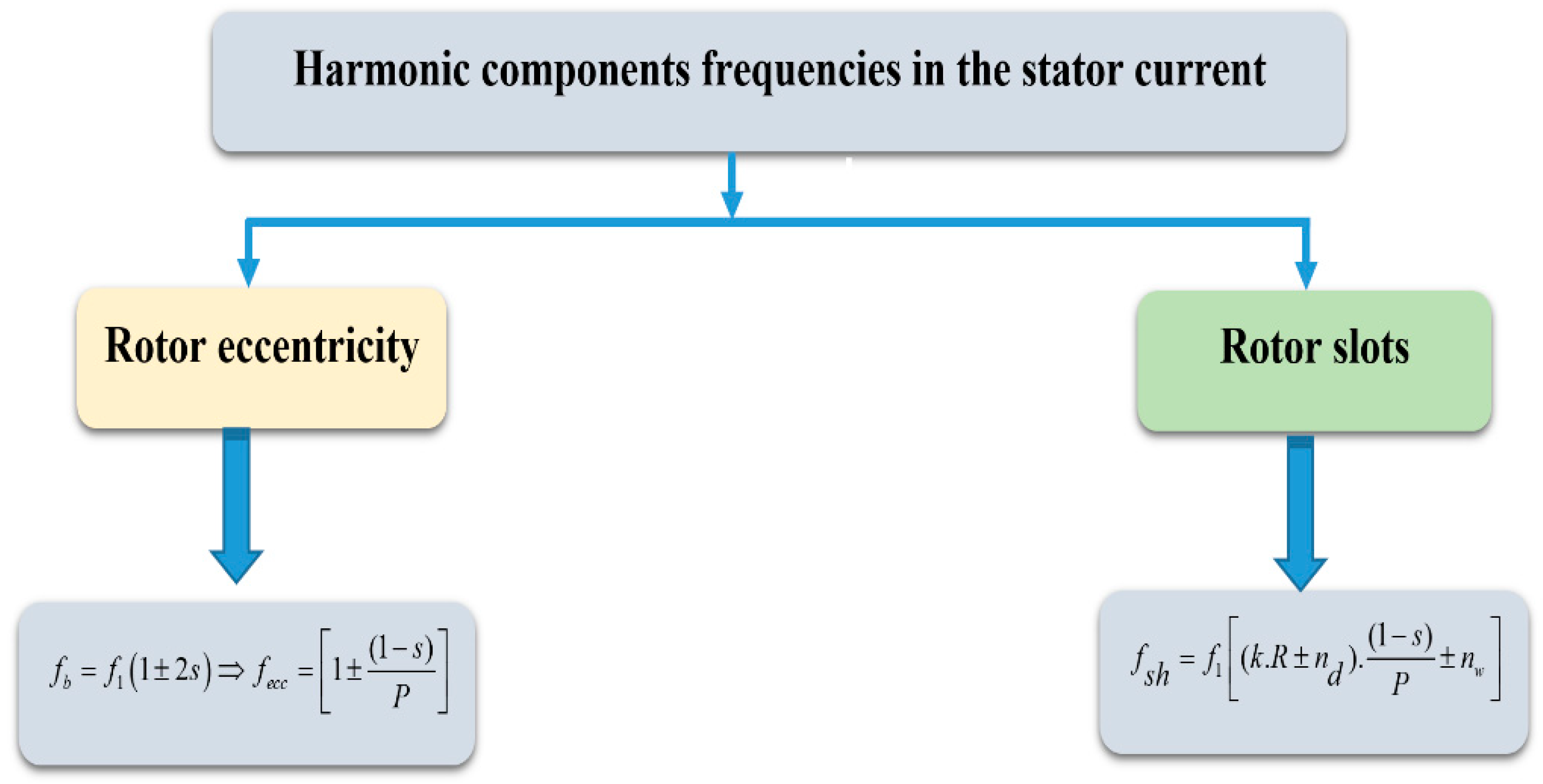
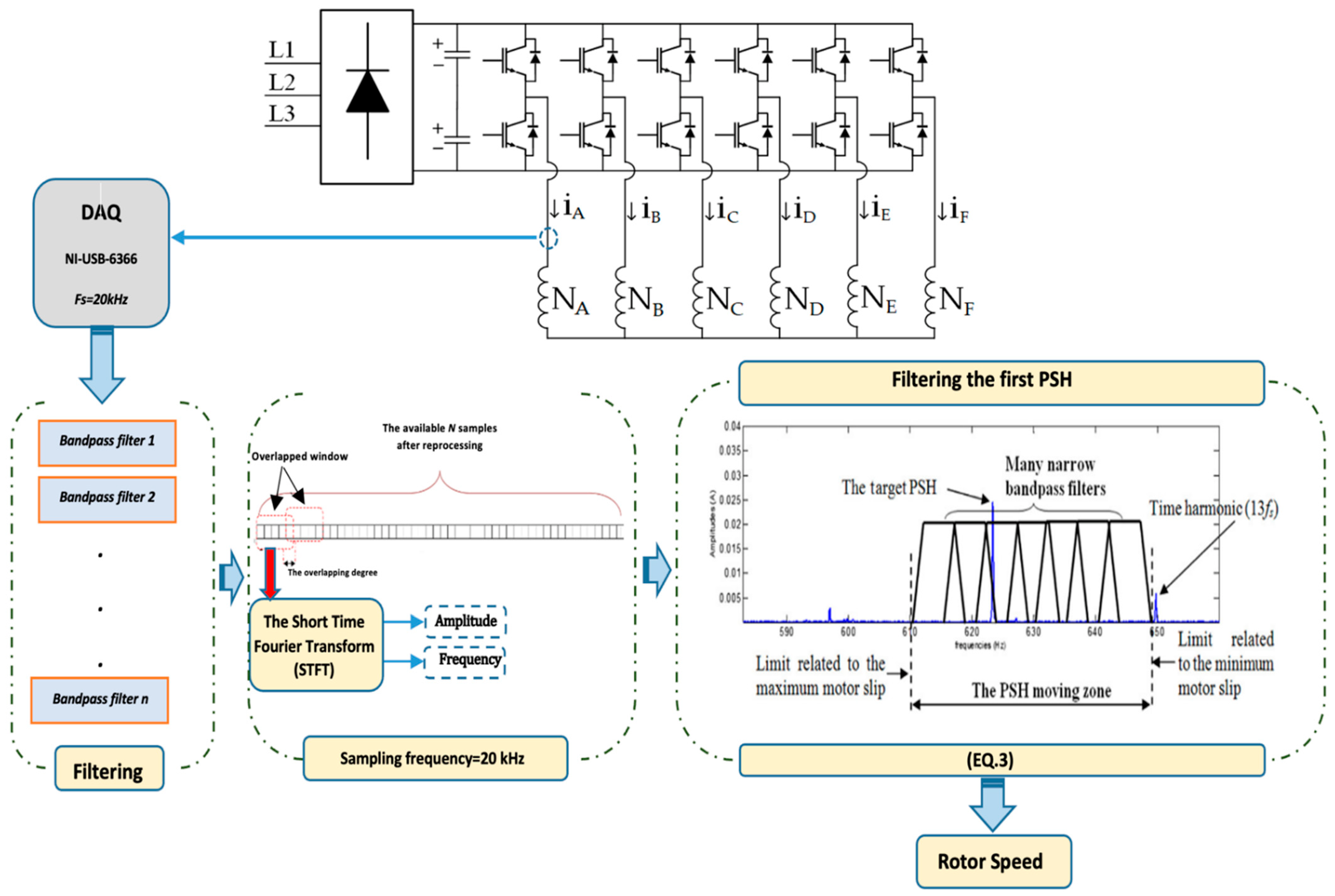
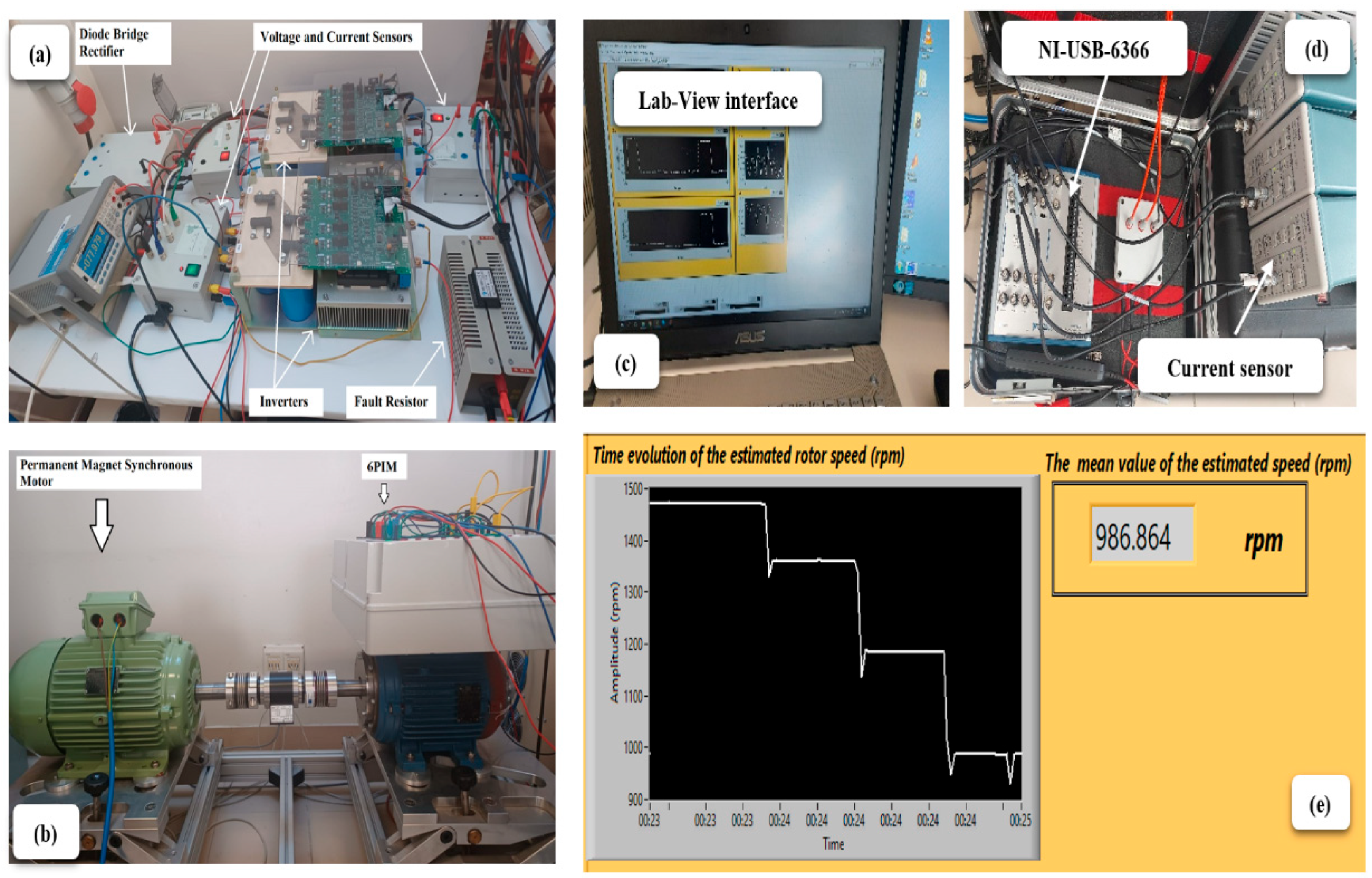
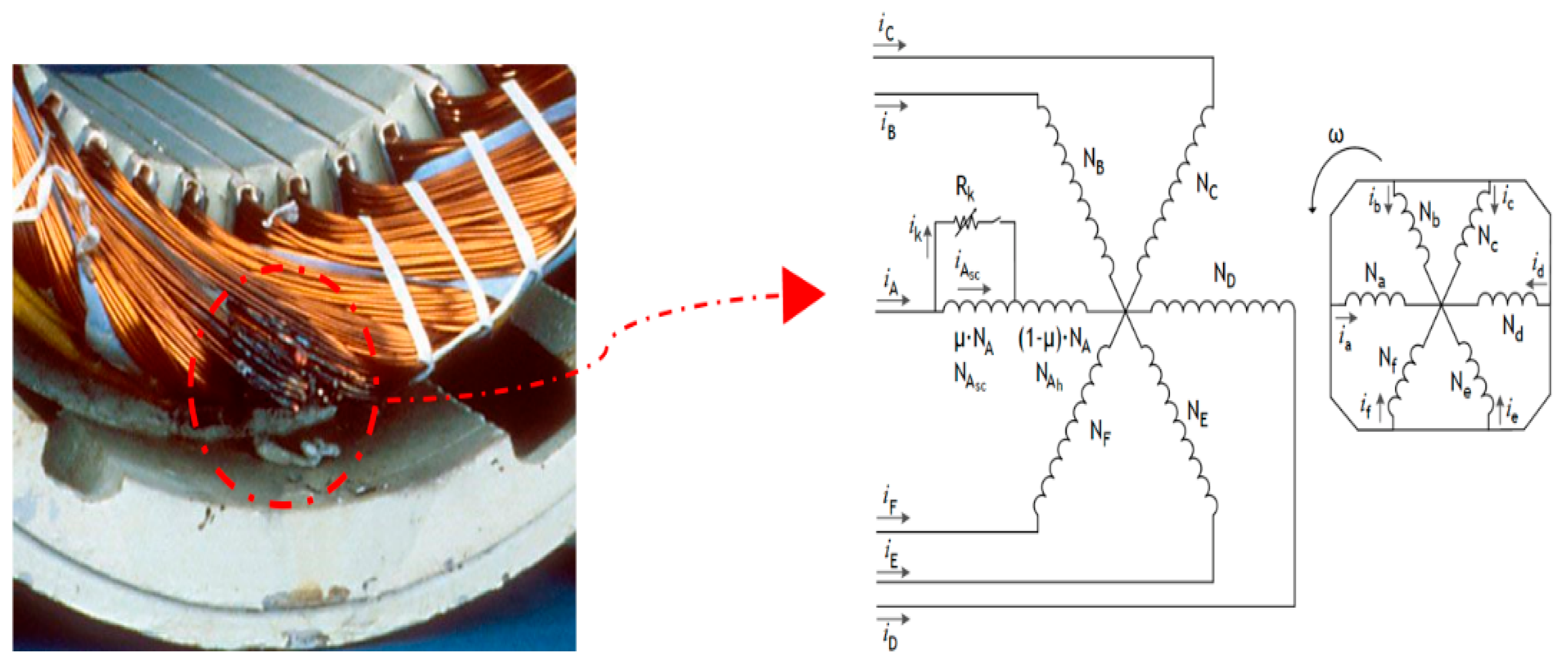

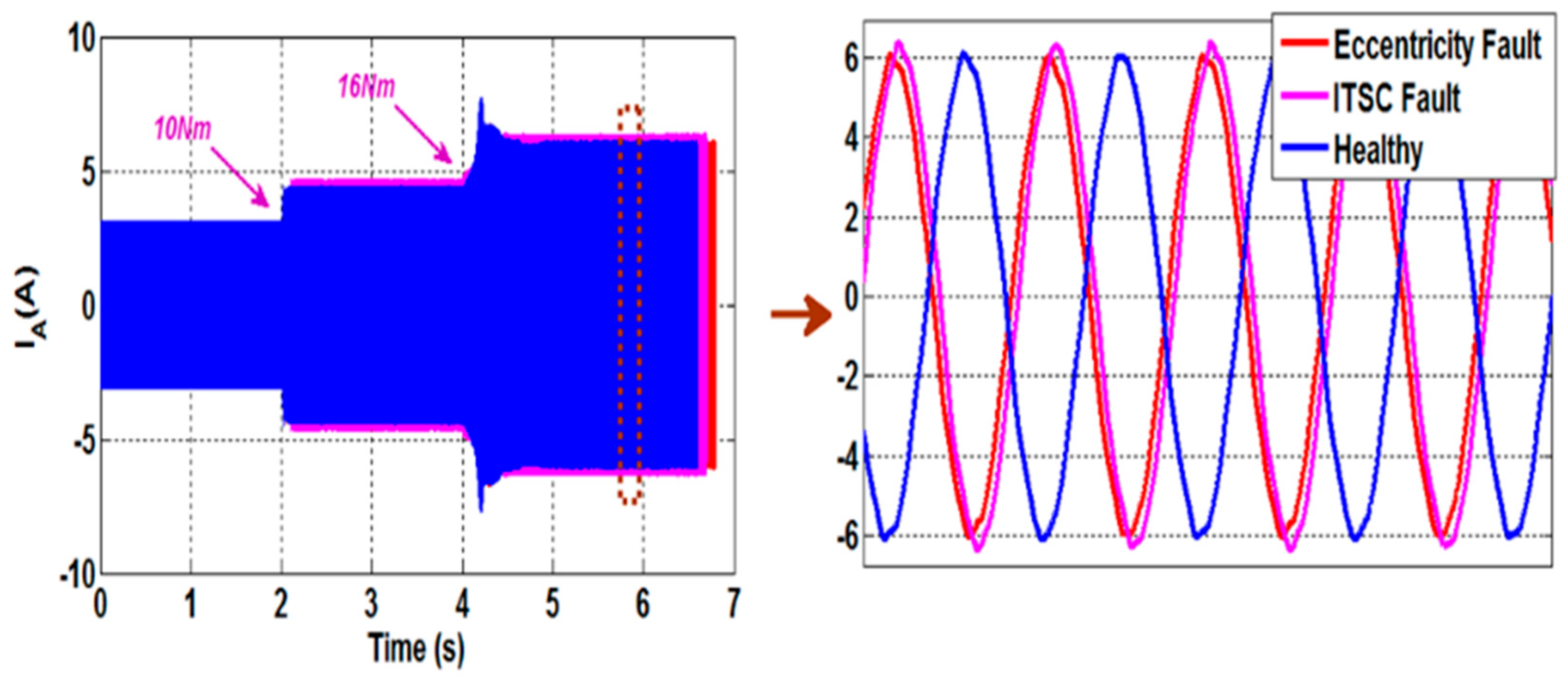
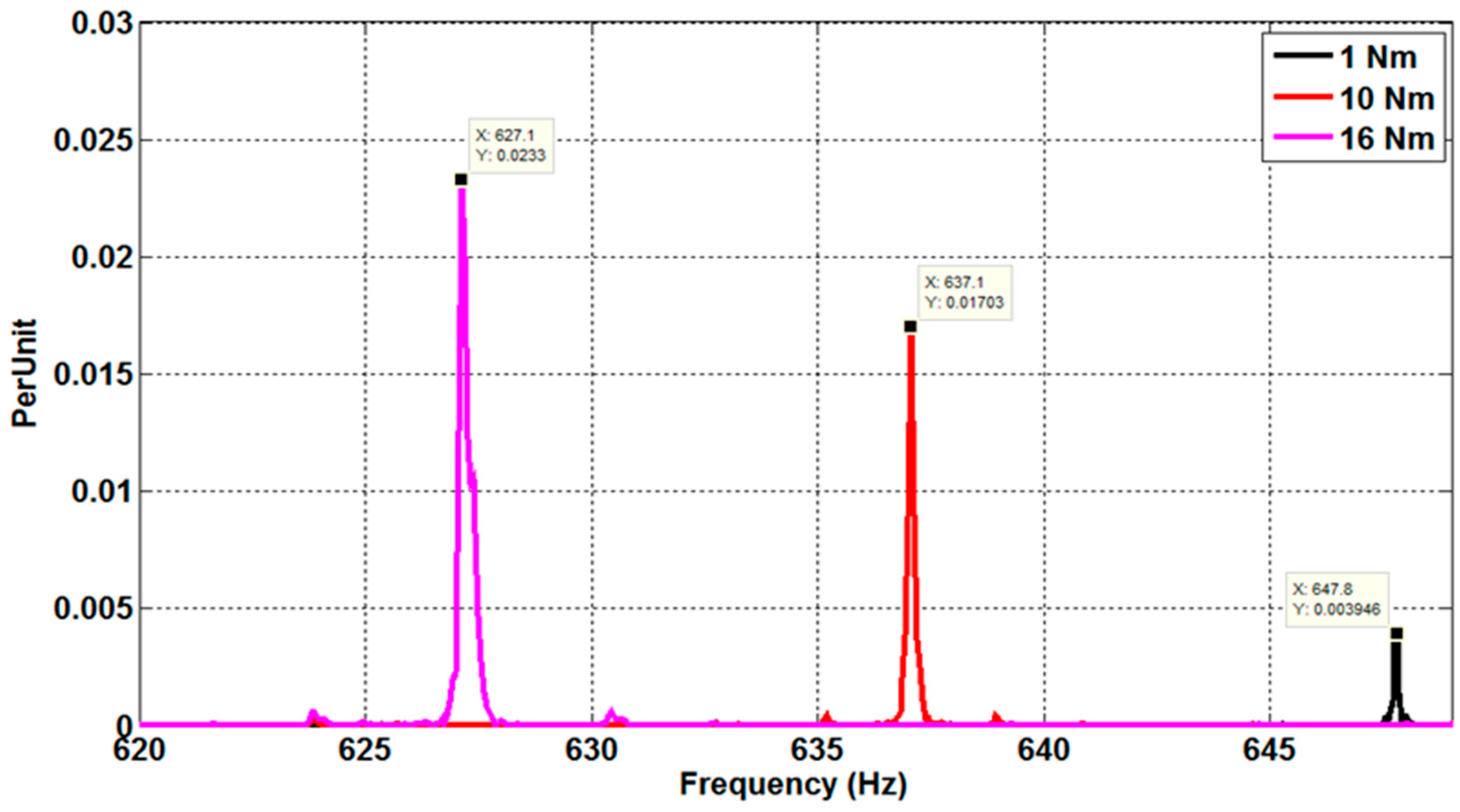
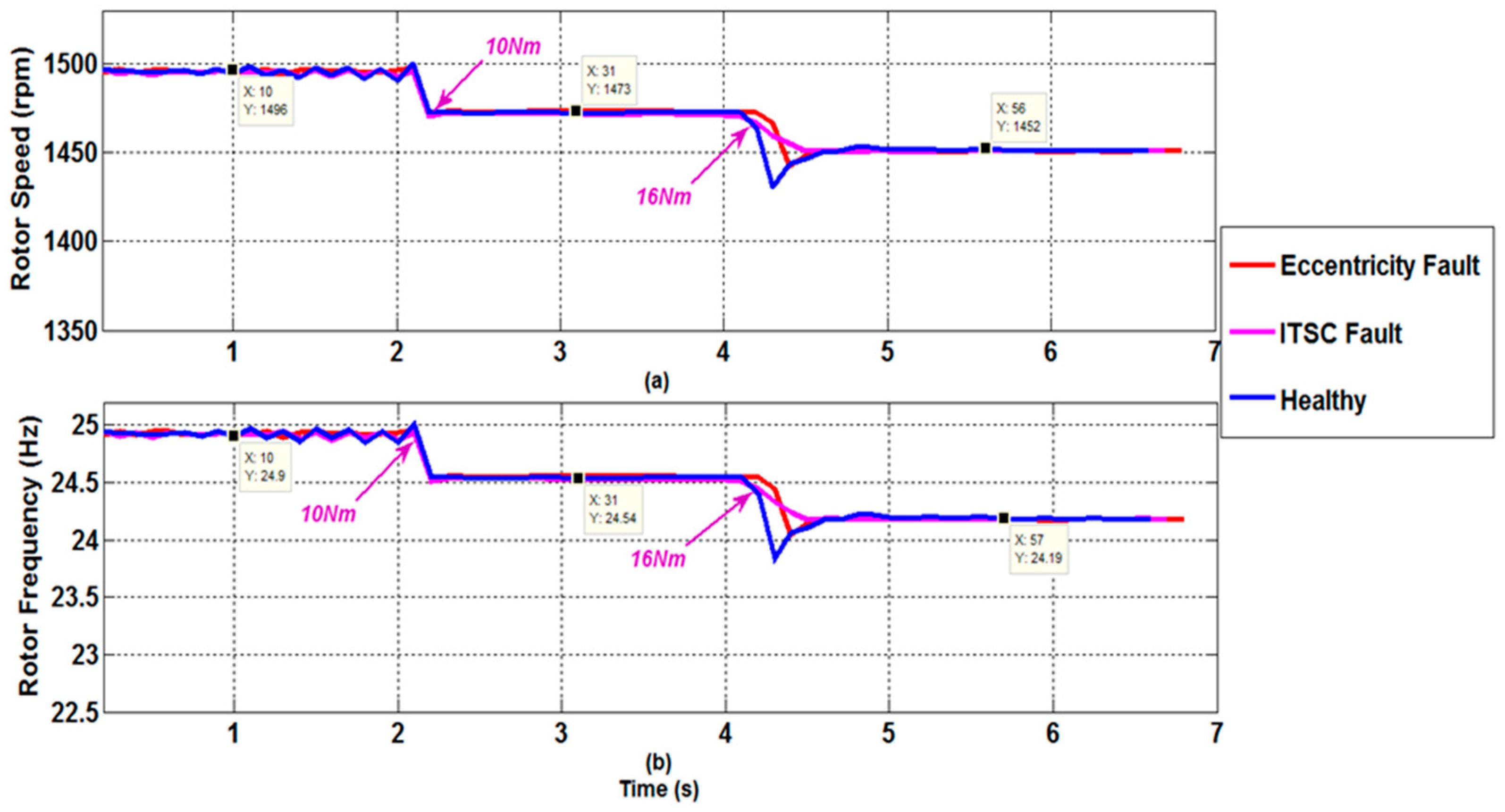
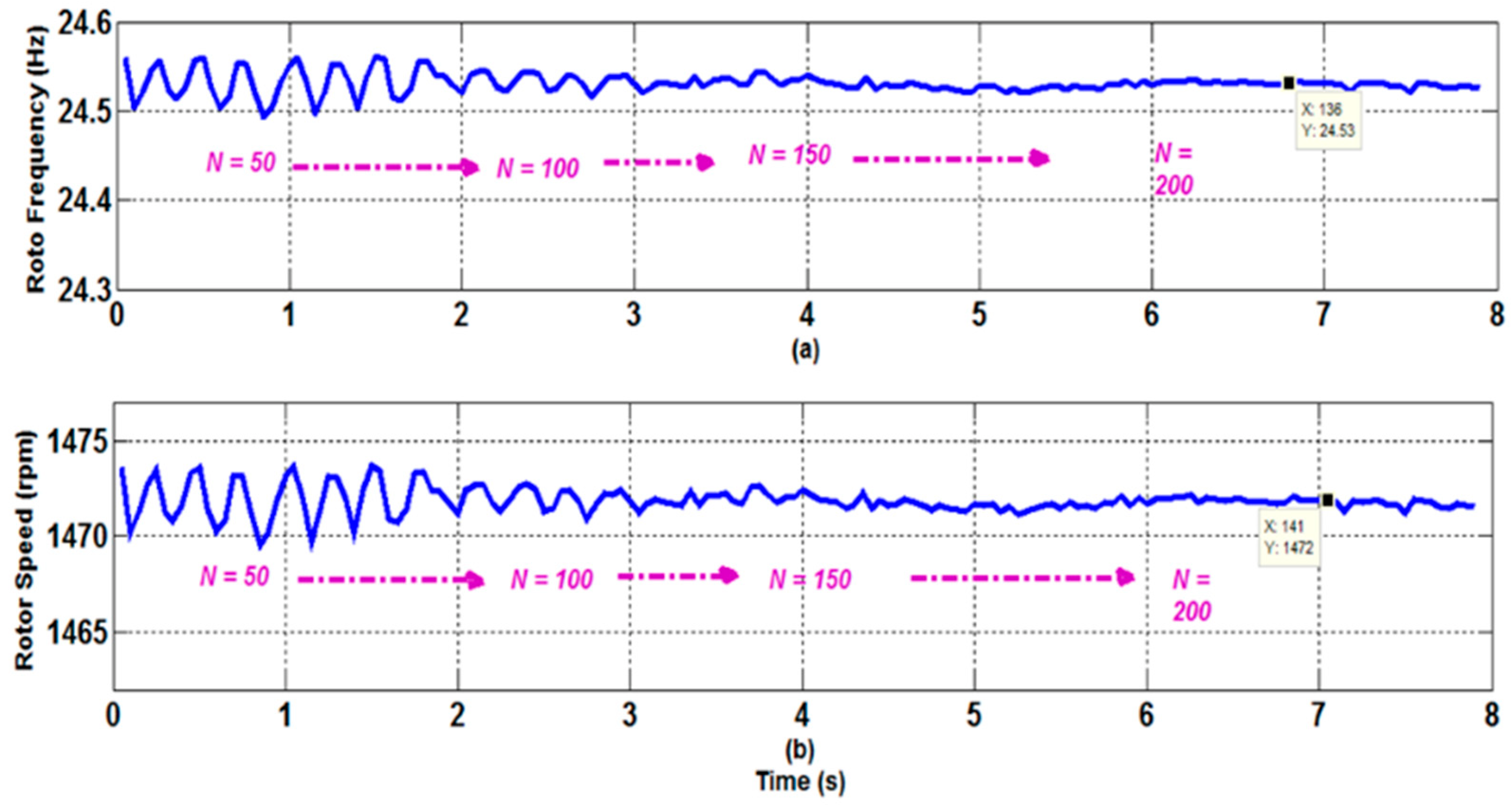

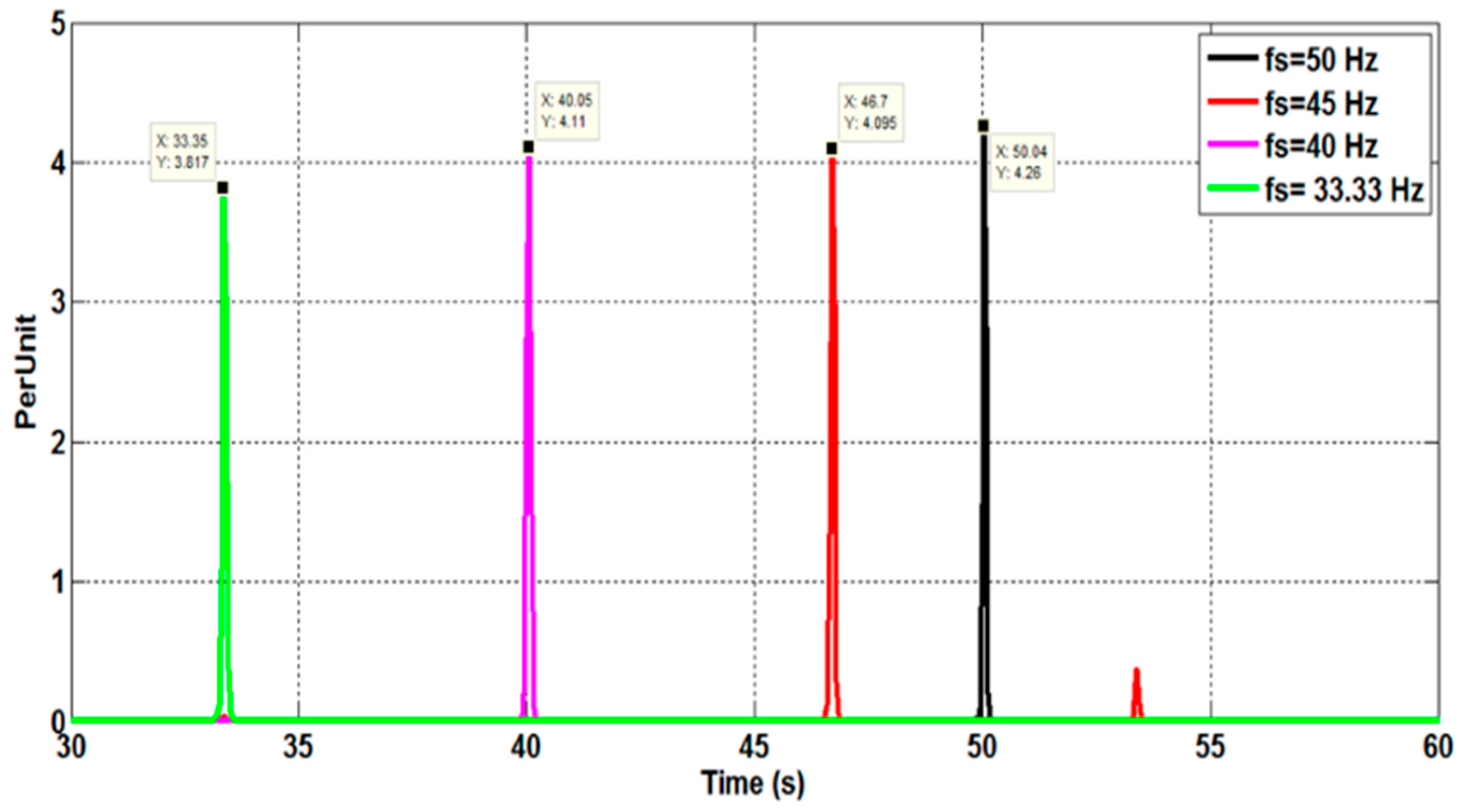

| Stator phase resistance (RS) | 1.87 Ω |
| Rotor phase resistance (Rr) | 2.98 Ω |
| Stator per-phase self-inductance (LA, LB, LC, LD, LE, LF) | 62 mH |
| Rotor per-phase self-inductance (La, Lb, Lc, Ld, Le, Lf) | 62 mH |
| Stator per-phase leakage inductance (Lσs) | 14.8 mH |
| Rotor leakage inductance (Lσr) | 14.8 mH |
| Mutual inductance between stator phases (MAB, MAF, MBC, MCD, MDE, MEF) and rotor phases (Mab, Maf, Mbc, Mcd, Mde, Mef) | 31 mH |
| Mutual inductance between stator phases (MAC, MAE, MBD, MBF, MCA, MCE) and rotor phases (Mac, Mae, Mbd, Mbf, Mca, Mce) | −31 mH |
| Mutual inductance between stator phases (MAD, MBE, MCF) and rotor phases (Mad, Mbe, Mcf) | −62 mH |
| Maximum value of the mutual inductance between stator and rotor phase (MSR) | 62 mH |
| Moment of inertia (J) | 0.02 N·m2 |
| Torque for losses and friction (Tav) | 0.23 N·m |
| Load Variation (1–16 Nm) (fs = 50 Hz) | ||||||||||||
|---|---|---|---|---|---|---|---|---|---|---|---|---|
| 1 Nm | 10 Nm | 16 Nm | ||||||||||
| Frequency (Hz) | Speed (rpm) | Frequency (Hz) | Speed (rpm) | Frequency (Hz) | Speed (rpm) | |||||||
| Measured Value | 24.9 | 1496 | 24.54 | 1473 | 24.19 | 1452 | ||||||
| Estimated Value | 24.9 | 1496 | 24.54 | 1473 | 24.19 | 1452 | ||||||
| Error (%) | 0 | 0 | 0 | 0 | 0 | 0 | ||||||
| Supply frequency variation (10 Nm) | ||||||||||||
| fs = 50 Hz | fs = 45 Hz | fs = 40 Hz | fs = 33.33 Hz | |||||||||
| Frequency (Hz) | Speed (rpm) | Frequency (Hz) | Speed (rpm) | Frequency (Hz) | Speed (rpm) | Frequency (Hz) | Speed (rpm) | |||||
| Measured Value | 24.53 | 1471 | 22.64 | 1358 | 19.72 | 1183 | 16.44 | 986.66 | ||||
| Estimated Value | 24.55 | 1472.2 | 22.67 | 1358.4 | 19.75 | 1183.3 | 16.48 | 999.65 | ||||
| Error (%) | 0.001 | 1.2 × 10−4 | 0.0016 | 2.9 × 10−4 | 0.0019 | 3.38 × 10−4 | 0.002 | 0.013 | ||||
Publisher’s Note: MDPI stays neutral with regard to jurisdictional claims in published maps and institutional affiliations. |
© 2022 by the authors. Licensee MDPI, Basel, Switzerland. This article is an open access article distributed under the terms and conditions of the Creative Commons Attribution (CC BY) license (https://creativecommons.org/licenses/by/4.0/).
Share and Cite
Laadjal, K.; Bento, F.; Antunes, H.R.P.; Sahraoui, M.; Cardoso, A.J.M. Speed Estimation of Six-Phase Induction Motors, Using the Rotor Slot Harmonics. Sensors 2022, 22, 8157. https://doi.org/10.3390/s22218157
Laadjal K, Bento F, Antunes HRP, Sahraoui M, Cardoso AJM. Speed Estimation of Six-Phase Induction Motors, Using the Rotor Slot Harmonics. Sensors. 2022; 22(21):8157. https://doi.org/10.3390/s22218157
Chicago/Turabian StyleLaadjal, Khaled, Fernando Bento, Hugo R. P. Antunes, Mohamed Sahraoui, and Antonio J. Marques Cardoso. 2022. "Speed Estimation of Six-Phase Induction Motors, Using the Rotor Slot Harmonics" Sensors 22, no. 21: 8157. https://doi.org/10.3390/s22218157
APA StyleLaadjal, K., Bento, F., Antunes, H. R. P., Sahraoui, M., & Cardoso, A. J. M. (2022). Speed Estimation of Six-Phase Induction Motors, Using the Rotor Slot Harmonics. Sensors, 22(21), 8157. https://doi.org/10.3390/s22218157










